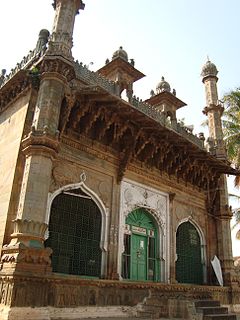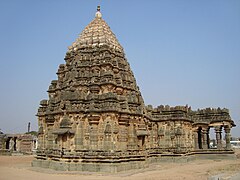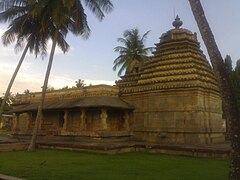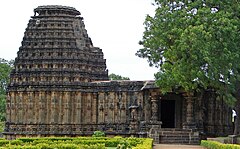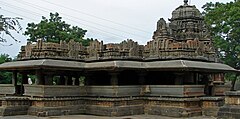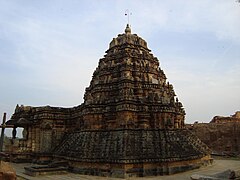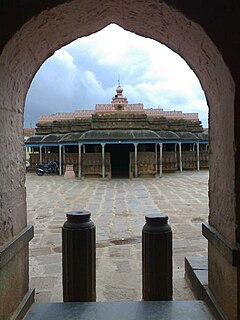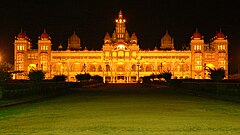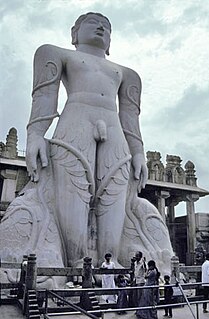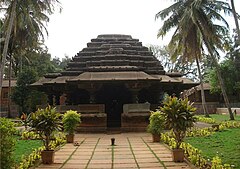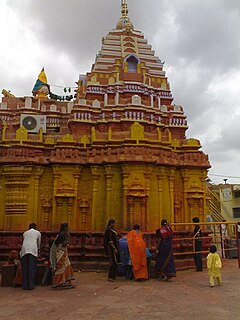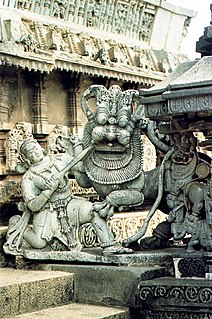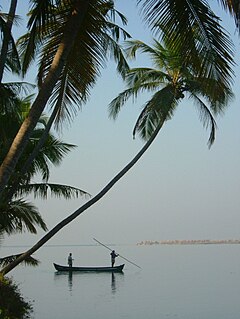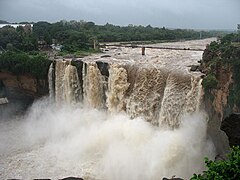Tourism in Karnataka
| State Department overview | |
|---|---|
| Type | State Department |
| Jurisdiction | Karnataka |
| Headquarters | Bengaluru, Karnataka, India |
| State Minister responsible |
|
This article's tone or style may not reflect the encyclopedic tone used on Wikipedia. (May 2008) |
This article is written like a manual or guide. (December 2017) |

Karnataka, the sixth largest state in India, has been ranked as the third most popular state in the country for tourism in 2014.[1][2] [3] It is home to 507 of the 3600 centrally protected monuments in India, second only to Uttar Pradesh.[4] The State Directorate of Archaeology and Museums protects an additional 752 monuments and another 25,000 monuments are yet to receive protection.[5]
The ancient sculptured temples, modern cities, hill ranges, forests and beaches are some tourism centers. Broadly, tourism in Karnataka is divided into four geographical regions: North Karnataka, the Hill Stations, Coastal Karnataka and South Karnataka.
The Karnataka government has introduced
The Karnataka State Tourism Development Corporation is the governmental body that works to promote tourism in Karnataka.[6]
North Karnataka

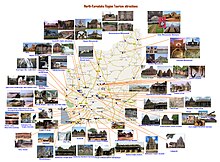
Utsav Rock Garden, a museum in the Haveri district, features a cultural heritage and educational tourist center. It is notable for having over 2000 sculptures relating to the depiction of rural life.
World heritage centres

- Tungabhadra. The rocky area near Anegundi to the north of the river has been identified as Kishkindha of Ramayana times.[citation needed] Hampi is home to a 29-foot-tall (8.8 m) monolithic Narasimha, which was installed by Krishnadevarayain 1529. The remains of palaces and gateways can be seen.
- Group of 8th-century CE monuments, Chalukyas and contains examples of 7th- and 8th-century temple architecture. Four temples are in the south Indian Dravidianstyle, four in the North Indian Nagara style and the last one, the Papanatha temple represents a hybrid of the two styles. The oldest temples are the Sangameshwara, Mallikarjuna and Virupaksha Temples.
Historical locations
Chalukya


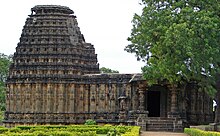

- Rashtrakutaand later Chalukya dynasties from the 6th to 12th centuries. It has a Jain and Vedic rock-cut shrine, both of about the 6th century. It has a Durga temple and pictures of the Tirthankaras. The meguti on a slope is a jaina basti with a Buddhist two-story rock-cut shrine below it and an Aihole inscription from Pulakeshin 2 above it. All the other Jain and Buddhist temples are built of stone and resemble Hindu temples. The temples were built during the Middle Ages before any style was established and hence there is a mixture of styles.
- Badami:[13][14] the capital of the early Chalukyas in the 6th century, is at the mouth of a ravine between two rocky hills. The town is known for its cave temples (all carved out of sandstone hills). Badami have four caves, the cave temple dedicated to Vishnu is the largest. In front of the cave temple, there is a reservoir called Aghastya Teertha dotted with temples on its bank. Among them, two are dedicated to Vishnu, one to Shiva and the fourth is a Jain Temple. Carvings in the cave temples display the Hindu gods, Narashima and Hari Hara. The temples also have paintings on the ceiling and bracket figures on the piers.
- Basaveshwarawas born here. It was an agrahara. The main temple here is in the Chalukya style and it was called as Sangamantha in records. The Samadhis of Siddharameshwara and Gurupadeshwara of the Inchageri school of spiritual pursuit are seen here.
- Kalyani Chalukyasperiod. Vijnaneshwara's Cave, Madivala Machiah's Pond, Akka Nagamma's Cave, fully renovated Siddheshwara temple and a new structure called Anubhava Mantapa, the Qaji's mosque and Raja Bagh Sawar Dargah.
- ChalukyaSomeshwara 4. In addition to Veerashaiva Mathas; there is a ruined Banashankari Temple and seven mosques and also an ancient Veerabhadra temple.
- Bankapura (80 km from Dharwad): Under Chalukya many temples were raised in the city including the Nagareshwara temple in the fort and another chalukya temple called Siddheshwara. Ali Adilshahi destroyed many temples in about 1567. There is a mosque in the fort.
- Gadag): It was a Buddhist centre. There are two notable chalukya temples called Doddabasappa Templeand Somewshwara Temple. Doddabassapa as polygonal star shaped temple garbhagriha and fine sculptural representations and huge nandi Temple. Someshwara could have been an old basati. The temple has a 400-year-old vast tank. There is an old Ganapathi image in an old ruined fort with a similar statue in a small shrine.
- Haveri: This town has the Siddheshvara Temple, built in the 12th century. It is situated in the heart of the city of Haveri, inside the garden.
- Kalyani Chalukyas into a vast complex.[16]The complex has triple shrines once housing Shiva, Brahma and Surya. The Saraswathi temple has shining decorative pillars, and a Saraswathi image that is notable as one of the largest examples of Chalukya art. The place has Someshwara and Rameshwara temples of Chalukya style. It has a Veeranarayana temple of Chalukya times.
- Kasivisvesvaraand Kalyani.
- Someshwara temple complex Gadag District, North Karnataka. The temple complex has the Someshwara temple of Shivaalong with other similar temples inside the fort-like compound.
- Tungabhadrariver.
- Haveri District, North Karnataka
- Mahadeva Temple (Itagi) in the Koppal district, North Karnataka, built during 1112 CE. This temple is an example of dravida articulation with a nagara superstructure. This Temple is also called Devalayagala Chakravarti in Kannada (Emperor among Temples).
- Panchakuta Basadi, Kambadahalli in Mandya district was built in the 8th century. This temple is one of the finest examples of South Indian Dravidian architecture of the Western Ganga.
- Shambulinga Temple, Hubli-Dharwad. This place is famous[citation needed] for Hindustani music[17]and Huge Shambulinga Temple.
- Hooli Panchalingeshwara Temple
- Lakshmeshwarhas Someshwara temple complex, Jain Basadis.
- Basavanna. The nearby Almatti Dam has got North Karnataka's biggest Rock Garden.
Rashtrakuta dynasty
- Malkhed, Kalaburagi district
- Gadag District
- Belgaum Fort
Kadamba dynasty

The second capital of the
Hanagal was the capital of Hangal
Banavasi was the capital of
Deccan Sultanates
- is the mausoleum of Muhammed Adil Shah and was built in 1659. It houses the world's second largest dome, unsupported by pillars. Malik-e-Maidan is a 55-ton cannon perched on a platform. The head of the cannon is fashioned into the shape of a lion whose jaws are trying to devour an elephant.
- Bidar:[20] a centre for Bidriware. It is the location of the tombs of 30 rulers including the Chaukhandi of Hazrat Khalil-Ullah Shah and Sultan Ahmed Shah Al Wali Bahamani from the Bahamani dynasty.
- Gulbarga
- Raichur
- Adilshahi, has a large crowning onion dome and Koranic scripture written in gold.
Rattas
- Navilateertha.
Jain Basadis

The
Navagraha Jain Temple at Varur near Hubli is one of the major pilgrimage. The temple features a 61 feet (18.6 m) tall monolithic idol of the Shri 1008 Bhagavan Parshvanatha and the smaller statues of the other 8 Jain teerthankaras.
Buddhist temples
- Tara Bhagavati temples, Balligavi, Shiralkoppa
- Gadagdistrict
- Sannati and Kanaganahalli, Kalaburagi district: remains of the razed stupas and a Buddhist plaques of Satavahana period were unearthed recently
- Aihole: Viharas
- Badami Chalukyasperiod were found between caves two and three
- Mundgod, Uttara Kannada: Tibetan settlements with multi-coloured stupas and painted prayer halls
- Gulbarga: Two new viharas
Shiva temples
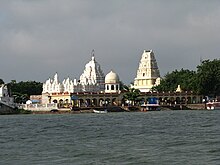
The Shiva temple at
The Veerashaivas have many venerated places, either associated with Basaveshwara or his contemporaries.
Athani has the samadhi of the Veerashaiva Saint Shivayogi. Some of the outstanding Veerashaiva Mathas are seen at Naganur near Bailhongal and Kalmatha in Belgaum, Durudundeshwara Matha at Arabhavi and Mahantaswamy Matha at Murgod are in Belgaum dt. Murugha Matha (Dharwad), Annadaneshwara Matha (Mundargi), Tontadarya Matha at Gadag and Dambal, Moorusavira Matha at Hubli, Murugha Matha and Hukkeri Matha (Haveri), Taralabalu Matha at Sirigere, Murugharajendra Matha at Chitradurga, Banthanala Shivajogi Matha at Chadachan and Mahantaswamy Matha (Ilkal) are equally notable. The samadhi of Sharanabasappa Appa at Gulbarga.
Shakti Sthala
The following places are visited by devotees of Shakti
- Chandralamba, Gulbarga
- Bagyawanti, Ghattaragi
- Mayavva, Chinchli
- Yellamma, Saundatti
- Banashankari, Badami, Bagalkote district
- Bhuvaneshwari, Hampi
- Varadahalli, Sagara, Karnataka
- Sigandur, Sagara, Karnataka
- Marikamba, Sagara, Karnataka
- Marikamba, Sirsi, Uttara Kannada
- Durga Parameshwari Kateel, Dakshina Kannada
- Mookambika Udupi District
- Mysore Mysore District
Temple tanks

- Agastya Teertha, Badami
- Mahakuta group of temples, near Badami
- Banashankari, near Badami
- Gadag
- Hampi
Coastal Karnataka

Coastal Karnataka is the stronghold of Hindu and Jain pilgrimage spots with
etc. The warm beaches of Karnataka are mostly unspoiled.Jamboti, 20 km south-west of Belgaum, has popular evergreen hilltop forests.
Karnataka is blessed with over 300 km of pristine coastal stretch. Netrani Island of Uttara Kannada is known for coral reefs. St. Mary's Island, a few kilometres from Udupi has basalt rock formations. Sunny beaches at places like Malpe, Murdeshwar, Maravanthe, Gokarna, Kumta have spectacular mountains to the east. Agumbe, Kodachadri hills, Kemmangundi, are just a few of many hill stations that straddle the coast providing tourists sun and greenery. Unlike many crowded hill stations in South India, the hill stations of Karnataka are still mostly undiscovered and pristine.
- Gokarna: The Coastal town of Gokarna is a pilgrimage centre as well as a centre of Sanskrit learning, 56 km from Karwar. It has the Mahabaleswar Temple with the 'Atmalinga' dedicated to Shiva. There is an enormous chariot, which is taken out in a procession on Shiva's birthday in February. The Tambraparni Teertha here is considered sacred to perform obsequies of the dead. There is a beach called Om Beach.
- Udupi: One of the holy place and it is 58 km from Mangalore. The Krishna temple here is founded by Acharya Madhwa during the 14th century. He founded eight mathas to conduct the services of Lord Krishna in turns. Paryaya festival is held once in two years in January. The place has Kadiyali Durga temple, Ambalapadi Shakti temple, Raghavendra Matha and the Venkataraman swamy temple. Malpe is the port near here. It has a beach and the Vadabhandeshwara temple of Balarama.
- Thantrady : One of the holy place and it is 22 km from Udupi. The brammasthana temple here founded by sri Ramanna bairy. It was an astabanda bramha. The main archaka of this temple is Nagaraj bairy.
- Padutirupathi).
- GommateshwaraMonolith, 11metres high dating back to 1604 in Venur.
- Malpe Beach: Situated 66 km north of Mangalore, near Manipal.[21]It has a tourist beach. The uninhibited St. Mary's Island, accessible by boat, has a beach and an impressive geological formation of basalt rock pillars into the sea.
- Dharmastala: Situated 75 km from Mangalore, Dharmastala is an attractive site surrounded by forested hills, rice fields and by the river Netravati on all sides. The Manjunatha temple here is a pilgrim centre. A Monolithic statue of Bahubali 14metres high was erected here in 1973. Visitors are provided with free boarding and lodging by the temple authorities. There is a small museum, Manjusha Museum located opposite to the temple. There are two temple chariots covered in wooden figures and all types of religious objects including carved and painted panels, bronze sculptures and bells.
- Kollur, 147 km from Mangalore: The temple of goddess Mookambika is located here on top of Kodachadri hill, at the foot of the Western Ghats. The goddess takes the form of a 'Jyotirlinga' incorporating aspects of Shiva and Shakti. It is a pilgrimage centre attracting lot of devotees.

- Moodabidre: Situated 35 km from Mangalore, Moodabidire has Jain temples known as Basti's. There are 18 Bastis, the oldest and the largest is the Chandranatha Basti (1429) with its 1000 pillared hall. 'The Jain Matha' near the entrance has an important collection of manuscripts. Other shrines worthy of mention are Shantinatha, Settara, Derama Setti Basti, Guru Basti, Kote and Vikrama Setti Basti.
- Bhatkal: located 135 km from Karwar was the main port of Vijayanagar empire in the 16th century. The ancient town has temples of Vijayanagar style and many Jain monuments. The 17th-century Hindu temple here in Vijayanagar style has animal carvings. 16 km away is the shore temple of Shri Murdeshwar. The temple attracts a lot of devotees and tourists.
- Honnavar: situated 90 km from Karwar, has a Portuguese fort. There is also a fort in Basavaraja Durga Island, amidst the sea which can be reached by a sail upstream on river Sharavathi.
- Ankola: Located 37 km south of Karwar, is a small town with 15th-century ruined walls of King Sarpamalika's fort and the ancient Shri Venketaraman Temple. Near the temple there are two giant wooden chariots carved with scenes from the Ramayana.

- Murdeshwar: The Murdeshwar Temple in Uttara Kannada District of Karnataka now possesses at 249-feet Raja Gopura. The Murdeswar temple complex is renowned for the tallest idol of Lord Shiva in the world, which is 123 feet. The latest addition to the temple, thanks to Mr. RN Shetty an entrepreneur and philanthropist, is the Rajagopuram, which was opened on 12 April 2008. Its Gopuram is regarded as exceptionally tall.
- The Rajagopuram of Murdeswar Temple has 21 floors, including the ground floor. The base measures 105 feet in length and 51 feet breadth. The gopura also possess a lift and visitors can go to the top and have an aerial view of the Arabian Sea and the statue of Lord Shiva. Another highlight is the life-size statues of two elephants at the base of the gopura.
- World's tallest Siva idol: The highlights of Murdeshwar lie beyond its beach and rural flair.[tone] On a little green hill, a 37 m (or 123 feet) Lord Shiva idol sits enthroned, surrounded by smaller statues illustrating moments of the Hindu mythology[citation needed]
Beaches
Karwar has a number of beaches like the Blue Lagoon Beach and Ladies Beach. Rabindranath Tagore described his experiences at Karwar beach in his poetry. Om beach, Murdeshwar are other notable beaches of Uttara Kannada Dist. The Nethrani Island near Murdeshwar. Basavaraja Durga near Honavar is an island fort raised by the Keladi Rulers during 16th and 17th centuries. It is surrounded by a strong fortification raised by gigantic laterite blocks and the hill has a flat top. Devagad and Kurmagad are two islands near Karwar. {Nirvana beach} at Kagal village of Kumta is a 5 km long beach in one stretch with white sand and transparent water in the month of December till March. The entire beach coastline is covered by Casuarina and coconut trees.
Planetarium
- Jawahar Lal Nehru Planetarium: Situated near Cubbon park, Bangalore. It organizes the shows in English and Kannada. Moreover, it has science center for educational activities.
South Karnataka
South Karnataka is a unique combination of spectacular
The river
- tourist attractions.

- Mandya: is a city, Sugar factories contribute majorly to the economy of the city. The Mandir of Shri Shirdi Sai Baba popular amongst local Sai Devotees as Mandyada Shri Shiradi Sai Baba Mandir is situated at B.Gowdagere, Gejjalagere village amidsts picturesque natural surrounding in Mandya District of Karnataka. The Mandir is situated at a distance of about 9.3 kilometers from Maddur town and about 12 kilometers from Mandya Town on Bangalore-Mysore State Highway. All the buses playing on Bangalore-Mysore route stops at B.Gowdagere Sai Baba Mandir Entrance situated on the highway. The temple is situated at a distance of just 1 kilometre from the main road. The Mandir is lovingly addressed by everyone as "Namma Tatathana Mane" (Our Grand Father's Home).
- Belur: Home to the Hoysala temple complex. The Chennakeshava temple here was completed in 1116 by Hoysala Vishnuvardhana. The image is 3.7 m tall and the temple standing on a platform has exquisite plastic art work on its outer walls and bracket figures of dancing girls in various poses in perfect proportion. There are shrines of Kappe Chenniga Andal, Saumya Nayaki etc. The temple here is a classic example of Hoysala art, and Belur was one of the Hoysala Capitals.


- UNESCO World Heritage Sites.[23]
- Arasikere: It is 41 km from Hassan and 176 km from Bangalore. It has coconut gardens. There is a Kattameshwara temple here which is also called Chandramoulishwara and referred to as Kalmeshwara in the records. It is a fine Hoysala monument with a rare polygonal frontal Mantapa with special design. There is a fine Haluvokkalu Temple and also a Sahasrakuta Jinalaya. Malekal Tirupathi near Arasikere has a venkataramana temple visited by many devotees.
- Ganga-Nalamba style of the 9th century. Its ceiling has a dancing Shiva sculpture with musical accompanists and eight Dikpalas surrounding him with all their paraphernalia. There is a Chennakeshava temple of the Hoysala style. An image of Vishnu lies in the garbhagriha. There are four Ganga temples.
- Madhugiri: It is 43 km from Tumkur and has a large hill fort. The ancient name of the place is Maddagiri. It has the temples of Venkataramana and Malleshwara built by Vijayanagara feudatories. There is also a Mallinatha basadi. The fort has gateways called Antaralada Bagilu, Diddibagilu, Mysore Gate etc. 19 km from here is another hill fort called Midigeshi.
- Madikeri or Mercara: Known as Scotland of India, Mercara known for its climate. It has many places of attraction such as Tala Cauvery, Nagarahole National Park, Abbe Water Falls, St. Mark's Church, Bagamandala, Cauvery Nisargadhama, Belegiri Hills, Thadiyanda Murali Kund, Igguthappa Temple, Irupu Falls And Coffee & Tea Estates.
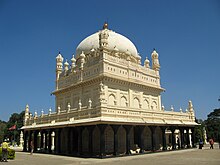
- Gumbaz, the mausoleum of Haider and Tipu. Both are impressive structures of Indo-Saracenic style. The palace has paintings, fine woodwork and it houses a museum.
- Melukote: It is a religious centre which attracts lakhs of people during its annual feast Vairamudi. The temple was reconstructed in the Hoysala style by Visnuvardhana with the guidance of Ramanujacharya, a Visistadvaitist, in the 11th century. There are Cheluvanarayanaswamy temple, Kalyani, Hill shrine of Lord Narasimha, Thottilamadu, Dhanuskoti, Academy of Sanskrit Research and many more to visit. The nearest tourist places are Thondanur, Srirangapatna, Karigatta, Nagamangala etc.,
- Mahadeshwara Betta: It is 220 km from Bangalore and 142 km from Mysore. It is very close to eastern Ghats. It is said that a saint called Mahadeshwara, who could ride a tiger, lived and had his gadduge here during the 14th and 15th centuries. The hill is full of thick forests and thousands of pilgrims visit the place.
- Talakadu: A Holy place on the banks of the Cauvery. It is full of sands, carried by the wind from the dried bed of the river. It was the second capital of the Gangas. They built the Pataleshwara and the Maruleshwara templeshere. Hoysala Vishnuvardhana built Kirti Narayana temple.


- Bhadravathi: It is an industrial town in Shimoga district 256 km away from Bangalore, which was earlier known as "Benkipura". There is a 13th-century Lakshminarayan Temple in Hoysala style. An iron and steel works, a cement factory and a paper factory are located on the banks of Bhadra river.
- Sagara City. The Aghoreshwara temple is a 16th-century monument of great attraction. There is also a Paravathi temple nearby. Keladi is another place nearby, the original capital. It has the Rameshwara and Veerabhadra temples. There is also a museum.
- Sravanabelgola: It has a statue of Lord Bahubali. The place is an important Jain pilgrimage center and has a long history. The 17 meter high statue of Bahubali is said to be the tallest monolithic structure in the world. It overlooks the small town of Shravanbelgola from the top of the rocky hill known as Indragiri. One can reach this hill after ascending 614 rock-cut steps.
- Somnathpura: It is the home to one of the best examples of Hoysala temple architecture, the Kesava Temple.

- Sagara City, Karnataka. The Sharavati river drops 253 metres in 4 separate falls known as Rani-the Rocket and Raja-the Roarer. The highest is the Raja with the fall of 253 metres and a pool below 40metres deep. The best time to visit is Late November to early January. The 50 km long Hirebhasgar Reservoir and the Linganamkki dam regulates the flow of the Sharavati river to generate the hydro electricity.
- Mekedatu: It is a picnic spot by the river Cauvery. It tumbles down through a deep ravine, on top of which is a chasm around 5 meters wide. Mekedatu is on Kanakapura Road.
- Hesaraghatta: Hesaraghatta has an artificial lake, a dairy and a horticulture farm. Boating and windsurfing are the other attractions. Also here is the Nrityagrama where young dancers are trained in all disciplines of traditional dance.
- Shivagange: A hill with four faces, rising to a height of 4599 ft looks like a Nandi from the East, Ganesh from the West, A Linga from the South and Cobra with it hood spread from the North side. It is accessible by road.
- Bharachukki, cascade down 90 meters. These falls are the source of Asia's first Hydro Electric Power Station called "Shimsa". The falls are in full splendour during July–August. The falls are 122 km from Bangalore.
- Hogenakkal Falls: These are also known as the 'smoking rocks' because of the mist. At the bottom of the 90 ft water falls, one can ride in a coracle.
- Devarayanadurga: This is a hill station of Tumkur road perched at a height of 3940 feet. A few kilometres from foot of the hills is a natural spring called Namada Chilume.
Palaces
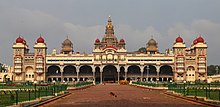
- Bangalore Palace
- Ambavilas Palace
- Nalknad Palace
- Rajendra Vilas
- Jaganmohan Palace
- Jayalakshmi Vilas Mansion
- Lalitha Mahal
- Cheluvamba Mansion, Mysore
- Shivappa Nayaka Palace
- Daria Daulat Bagh
Forts
In Karnataka there are thousands of Forts, in Kannada called as Kote or Gad or Durga.











